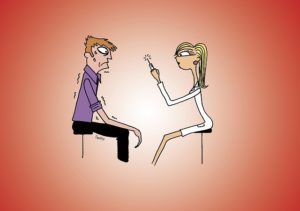Last week I posted part 1 of a 2 part series called “The Complete Anxiety Disorder Encyclopedia”.
I wanted to create this series to help spread awareness about the diversity of anxiety and what it looks like. This is part 2, where we go over some other anxiety disorders not mentioned in part 1. If you haven’t read the first part, click here!
1. Post-Traumatic Stress Disorder
Also known as PTSD, this is an anxiety disorder that emerges after someone experiences an incredibly traumatic experience. PTSD can be acute (meaning short-term), or it can be chronic (long-term).
It’s categorized by severe anxiety when exposed to something that reminds the individual of the traumatic experience. It also includes general anxiety, depression and fear post traumatic event
The traumatic experiences all vary, but are typically exposures to different types of cruel and inhumane treatment.
PTSD is one of the reasons why “trigger” became such a popular term in recent years. The word trigger refers to something that reminds a person of a trauma they experienced, and will thus elicit distress for the individual.
Folks with PTSD may have flashbacks, panic attacks, or completely disassociate when confronted with their trauma.
It’s important to note that yes, it is possible for the person to get violent if they are faced with a trigger, however that is the exception and not the rule.
PTSD has been wrongly painted as a disorder only experienced by war veterans. We also often hear horror stories of these vets going on violent sprees and murdering loved ones. And while this has happened, it is definitely not common.
Therapies often used in aid of this disorder are Exposure Therapy and Cognitive Behavioural Therapy.
Medications can greatly vary depending on what the person is experiencing. In a case of potential hallucinations or delusions, the person may even benefit from anti-psychotic medication. Otherwise prescription medications tend to be anti-depressive and anti-anxiety.
2. Specific Phobias
Severe phobias actually also fall into the category of anxiety disorders.

Phobias are categorized by severe anxiety, fear and distress when confronted with a specific stressor. Often this stressor is specific to the individual.
Common phobias are: spiders, clowns, the dark, small spaces, big spaces, holes in things etc.
For phobias, Exposure Therapy is most often used but CBT may also be beneficial. Medication is likely not going to be needed as phobias don’t tend to bleed into our daily lives the way other anxiety disorders do. However, it may be helpful for some folks.
3. Body Focused Repetitive Behaviours
These are a cluster of habitual behaviours that can include things like: hair pulling, nail biting, skin picking, cheek and lip biting.
These behaviours fall under “Obsessive Compulsive and Related Disorders” of the DSM-5, just like OCD.
Despite this categorization both of these conditions have components of anxiety which is why I have added them to this list. (Fun fact: OCD used to be under “Anxiety Disorders” before).
Anxiety is incorporated in Body Focused Repetitive Behaviours because it’s anxiety that often triggers the behaviours. So for example, someone may start hair pulling (Trichotillomania) after a fight with a friend because it was anxiety inducing.
Alternatively, individuals will sometimes partake in these actions unconsciously and with no reason whatsoever. However, this is more common in children than it is in adults.
Lastly, anxiety seeps into BDFB’s by distressing the person when they can’t control their actions, and by judgement of others.
Therapies and medications vary a lot depending on the age of the person and the severity of their behaviour, so it wouldn’t be appropriate to offer any baseline for this condition.
5. Health-related anxiety

We’ve all experienced Health Anxiety when we thought we were sick or something was wrong with our bodies. So on its own, anxiety over health is not a disorder.
However, there are health-related anxiety disorders such as Hypochondria that are defined by obsessive worry and fear about physical health, often reaching levels of obsession and manic.
An example of Hypochondria is thinking you have cancer despite the fact that every test you’ve done has shown negative. But regardless, you still think you have it.
Therapy for health related anxiety disorders would likely be CBT, or simply Cognitive Therapy. Medication would vary a lot depending on the person and the levels of severity.
6. Social Anxiety/Phobia Disorder
This is an anxiety disorder that can actually also fall under the specific phobias category, much like Agoraphobia (discussed in part 1).
While media has painted social anxiety to look like a shy, introverted and awkward person, this isn’t actually the case.
Social anxiety/phobia disorder is clinically defined by a fear of being judged by others, or making a fool of oneself in front of others.
This doesn’t necessarily mean that the person has poor social skills or is quiet. While they certainly can be, it’s not part of the diagnostic criteria.
For example, some people may actually talk a lot and be charismatic to compensate for their nervousness. But the whole time they would be anxious, and likely feel embarrassed afterwards.
The point is that you’re anxious and scared of how you will be perceived by others as you don’t want to embarrass yourself, not necessarily that you’re antisocial.
CBT and Exposure Therapy would be the ideal therapies for this condition. The person may also benefit from anti-anxiety medication or anti-depressants.
7. Separation Anxiety Disorder
Once thought to only be a disorder exclusive to child and adolescents, the DSM-5 has now changed its criteria to also include adults.
As the name suggestions, this anxiety disorder revolves around an individual experiencing severe anxiety and fear when separated from those they are closest to.

This type of anxiety is normal in babies around the 1 year mark, and again around the 3-5 year mark.
However, the problem arises when the anxiety is extreme, frequent, persistent, and changes the quality of life for the person (as is the pattern with all of these disorders).
This disorder can happen due to trauma of abandonment in a child, or sometimes for no actual reason aside the child being more anxious than average.
Fun fact: Separation Anxiety Disorder can even be present in animals, especially ones that have been abandoned.
Therapies and medications can vary depending on the age of the person and the severity of the disorder.
But typically CBT, Exposure Therapy, or other behavioural therapies are used, as well as potential anti-anxiety medication.
8. Hoarding
Hoarding is categorized by 3 main things:
- Severe anxiety and inability to throw away possessions despite their lack of value as well as a desire to obtain new things (often non-essential)
- A living space that is so cluttered it cannot be used for its actual purpose
- Severe impairment in areas such as relationships, mental health, physical health, finances etc.
Individuals grow a form of attachment to the objects despite their worthlessness, and become extremely upset and anxious if they have to get rid of it.
While Hoarding can stand alone as its own disorder, it can also be a part of other disorders such as Schizophrenia and OCD. Also, those with Hoarding likely also experience other mental illnesses such as depression, GAD, social anxiety etc.
Intensive and immediate therapy such as CBT or Exposure Therapy will be needed for this disorder.
9. Selective Mutism
This is a very rare anxiety disorder that is only found in children.
Selective Mutism is an anxiety disorder categorized by a child not verbally communicating in certain situations despite their ability to be able to talk comfortably otherwise.
For example, maybe the child speaks normally when at home playing, but will not speak at class when a teacher asks them to answer a question.
This seems to stem from anxiety about the situation. Please note that getting upset at your child in this circumstance is not going to be helpful.
Instead, Behavioural therapy may be beneficial. As this is a child exclusive disorder, medication may not be recommended.
Final Thoughts
This sums up my Anxiety Disorder Encyclopedia Series! I hope you have learned about new anxiety disorders you didn’t know about before, and now better understand all the different faces of anxiety. Is there an anxiety disorder that you found really interesting? Let me know in the comments below!
All my love,
T

